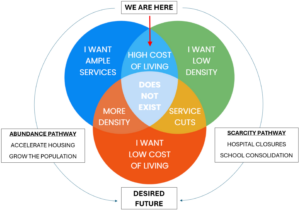It’s that time of the year again! United Van Lines and U-Haul have published their annual studies on migration patterns. We begin with our interpretation of the study results followed by summaries of the data below.
It’s important to remember that these studies analyze proprietary data based only on the utilization of their respective services. There are many moves that take place with other service providers or your friend with a big truck that owes you a favor. It is not a representative sample of population-level migration patterns. Nonetheless, the data are still interesting, and track real moves that occurred.
Let's Get Moving
Vermont ranked 1st again in the United Van Lines study. High ratios of inbound moves to Vermont in the United Van Lines data are an indicator of continued interest in what our state has to offer. Even though Vermont fell to 30th in the U-Haul rankings, the number of inbound one-way trips is still greater (just barely) than the outbound number.
Based on the United Van Lines study, households moving to Vermont that are utilizing their services tend to have higher income. Though demographic data isn’t available from the U-Haul study, customers opting for DIY moves are likely more sensitive to price compared to clients that choose contract movers.
There are many reasons why people decide to move such as jobs, family, lifestyle, cost-of-living, etc. At the end of the day, feasibility is what converts interest into action.
Vermont can do much more to make moving here, or staying here, more feasible. It’s imperative that we do this given our aging population. Our state continues to face a workforce shortage that is projected to become even more problematic over the next decade with a wave of baby boomers retiring.
Vermont’s drop in the U-Haul rankings while staying at the top of the United Van Lines list could be interpreted as a bellwether for the market-driven restructuring of Vermont’s population along socioeconomic lines. Our inadequate supply of housing in Vermont creates an unfair game of musical chairs that favors the wealthy.
The Vermont Futures Project wants to see a greater total number of people choosing Vermont and for access to be equitable regardless of socioeconomic status.
How do we make this happen?
By building more housing of all types. There is more demand than supply which is reflected in housing market prices. The answer isn’t to suppress demand by shutting people out – that would be counterproductive and lead to more inequality. The answer is to increase supply to meet demand. It requires housing of all types because affordability is a spectrum and options need to be available across the spectrum to enable mobility in the housing market.
It’s great to see Vermont on top of list of Top Moving Destinations for 2022 in the United Van Lines study and we hope Vermont will top the list again next year. This should be celebrated! However, there’s still much more work to be done as signaled by the U-Haul data. Living and working in Vermont should be a choice accessible to all people.
We’ll keep digging past the headlines and into the data. A sign of progress would be an increase in the absolute number of inbound moves to Vermont along with a more equitable distribution among movers across the socioeconomic spectrum.
That’s not up to United Van Lines or U-Haul though; that’s up to us here in Vermont.
Let’s get moving!
The U-Haul growth index also ranks states based on the ratio of inbound vs. outbound moves by tracking one-way rentals. In 2021, Vermont ranked number 12. We’ve fallen to number 30 in the 2022 rankings.
According to the Vermont Business Magazine’s analysis of U-Haul data, People arriving in Vermont in one-way U-Haul trucks rose 4% from 2021, while departures increased 6%. Despite a greater year-over-year jump in departures, do-it-yourself movers arriving in Vermont still accounted for 50.1% of all one-way U-Haul truck traffic in and out of the state (49.9% departures).
New England dropped significantly from 2021 to 2022 in U-Haul’s growth index:
2021 Rank –> 2022 Rank
- Connecticut: 18 –> 28
- Maine: 8 –> 29
- Massachusetts: 47 –> 47
- New Hampshire: 25 –> 38
- Rhode Island: 32 –> 40
Vermont Tops the List by Percentage: 77% of Vermont moves were inbound, 23% were outbound. Vermont was first by a large margin. Oregon had the second highest inbound ratio at 67%.
Vermont Inbound – Job (39.5%) and family (38.5%) were the top two primary reasons listed for inbound movers. Only 31% were under the age of 45. 81.5% of inbound movers reported an income above $75,000. For comparison, the median household income in Vermont for 2021 was $67,674.
- Vermont Business Magazine says, “Those who moved into Vermont tended to be older and wealthier.”
Vermont Outbound – Job (75%) and Lifestyle (25%) were the only two primary reasons listed by outbound movers. 100% of outbound movers were 45 years old or older, and 100% of them reported incomes above $150,000.
- Vermont Futures Project says, “Those who moved out of Vermont tended to be even older and even wealthier than those who moved in.”
Vermont still needs more people.
Relative data (percentages) and absolute numbers tell two very different stories. The total number of shipments involving Vermont in 2022 was only 277. Of these shipments, 213 were inbound and 64 were outbound.
This was the lowest number of total shipments for any state in the data. Yes, we may have had the best inbound ratio (77%) of any state, but even 100% of a small number is still a small number.
To provide some context for comparison, here are the number of total shipments for our New England neighbors:
- Connecticut – 2,223
- Maine – 1,039
- Massachusetts – 4,175
- New Hampshire – 811
- Rhode Island – 702
The United Van Lines 2022 National Movers Study press kit contains additional data, including a map, the complete inbound/outbound rankings for states and metropolitan statistical areas and five-year trends. Download Now.



